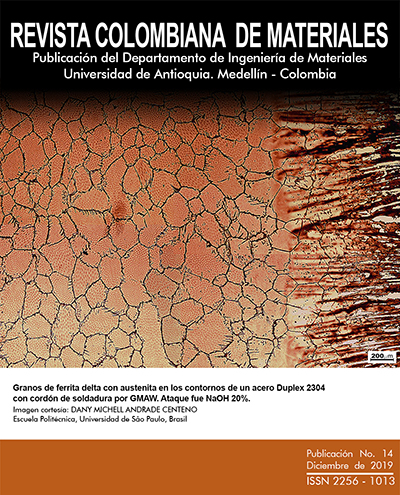Effect of Zr grain refinment on the tensil and hardness properties of the system Cu8Sn ̈as-cast ̈ under standart test ASTM B208-140
DOI:
https://doi.org/10.17533/udea.rcm.340841Keywords:
inoculation, as-cast structure, bronzes, mechanical tests, fractographyAbstract
The grain refinement carried out through the inoculation of alloys of phosphor bronze “as-cast” has been studied for several years with the purpose of establishing an effective methodology that allows obtaining alloys with refined grain structure and without the need to apply thermal treatments to the alloys produced. In the present project, the refining effect of zirconium on the grain size and mechanical properties (tensile and hardness) of phosphor bronze (as-cast) alloys (Cu8Sn) was studied; two alloys Cu8Sn-0% Zr, and Cu8Sn-0.16% Zr were produced. These alloys were obtained by casting and casting in a mold of sand hardened with phenolic resin. Once the pieces were produced in accordance with ASTM B208-140 [10], they were cut and machined to achieve tensile specimens, with the purpose of performing tensile and hardness tests and performing fractographic analyzes. The results showed that a 55.35% reduction in the average grain size of the alloy was obtained and that the ultimate tensile strength, yield limit, modulus of elasticity and breaking stress of the Cu8Sn- alloy 0.16% Zr were greater than those of the Cu8Sn-0% Zr alloy. The fracture analysis allowed determining that the fracture at the macroscopic level of both alloys was cup and cone, at the microscopic level it was determined that there were two modes of fracture occurrence: dendritic detachment fracture and microcavities coalescence fracture. Both modes of fracture are typical of ductile alloys.
Downloads
References
W. Reif and G. Weber, “Grain refining copper alloys, UK patent GB2179673A.” pp. 1–13, 1985.
Z. Liu, “Review of Grain Refinement of Cast Metals Through Inoculation: Theories and Developments,” Metallurgical and Materials Transactions A, vol. 48, no. 10, pp. 4755–4776, 2017.
J. A. Patchett and G. J. Abbaschian, “Grain refinement of copper by the addition of iron and by electromagnetic stirring,” Metallurgical and Materials Transactions A B, vol. 16, no. 3, pp. 505–511, 1985.
M. Johnsson, L. Backerud, and G. K. Sigworth, “Study of the mechanism of grain refinement of aluminum after additions of Ti- and B-containing master alloys,” Metallurgical and Materials Transactions A, vol. 24, no. 2, pp. 481–491, 1993.
M. J. Balart, J. B. Patel, F. Gao, and Z. Fan, “Grain Refinement of Deoxidized Copper,” Metallurgical and Materials Transactions A, vol. 47, no. 10, pp. 4988–5011, 2016.
M. Johnsson, “Grain refinement of aluminium studied by use of a thermal analytical technique,” Thermochimica Acta, vol. 256, no. 1, pp. 107–121, 1995.
J. M. Rojas Arango, “REFINO DE GRÃO DAS LIGAS DO SISTEMA COBRE-ESTANHO,” Escola Politécnica da Universidade de São Paulo, 2016.
J. . Davis, ASM specially handbook: Copper and copper alloys. Materials Park, OH: ASTM International, 2001.
A. Couture and J. O. Edwards, GRAIN REFINEMENT OF SAND CAST BRONZES AND ITS INFLUENCE ON THEIR PROPERTIES., vol. 81. 1974.
ASTM B208-14: “Standard Practice for Preparing Tension Test Specimens for Copper Alloy Sand, Permanent Mold, Centrifugal, and Continuous Castings”, 2014.
G. F. Vander Voort, Metallography: Principles and Practice. ASM International, 1999.
ASTM E112-13: “Standard test methods for determining average grain size”, 2013.
ASTM E8/E8M - 16a: "Standard Test Methods for Tension Testing of Metallic Materials”, 2016.
T. E. Quested, “Literature review. Understanding mechanisms of grain refinement of aluminium alloys by inoculation,” vol. 20, no. November, pp. 1357–1370, 2004.
M. A. Easton, M. Qian, A. Prasad, and D. H. Stjohn, “Recent advances in grain refinement of light metals and alloys,” Current Opinion in Solid State & Materials Science., vol. 20, no. 1, pp. 13–24, 2016.
D. A. Ramirez Hernandez, “OPTIMIZACIÓN DE LAS CONDICIONES DE FABRICACIÓN DE PROBETAS DE TRACCIÓN DE BRONCES AL ESTAÑO FUNDIDOS E INOCULADOS CON ZIRCONIO,” Universidad de Antioquia, 2018.
M. Ipohorski and R. J. Acuña, “Fractografia, Aplicación al análisis de fallas,” Com. Nac. Energía Atómica. República Argentina, 1988.
M. Möser, “Chapter 15 Fractography with the SEM (Failure Analysis),” Electron Microscopy in Solid State Physics, 2007.
Downloads
Published
How to Cite
Issue
Section
License
Copyright (c) 2019 Revista Colombiana de Materiales

This work is licensed under a Creative Commons Attribution-NonCommercial-ShareAlike 4.0 International License.








